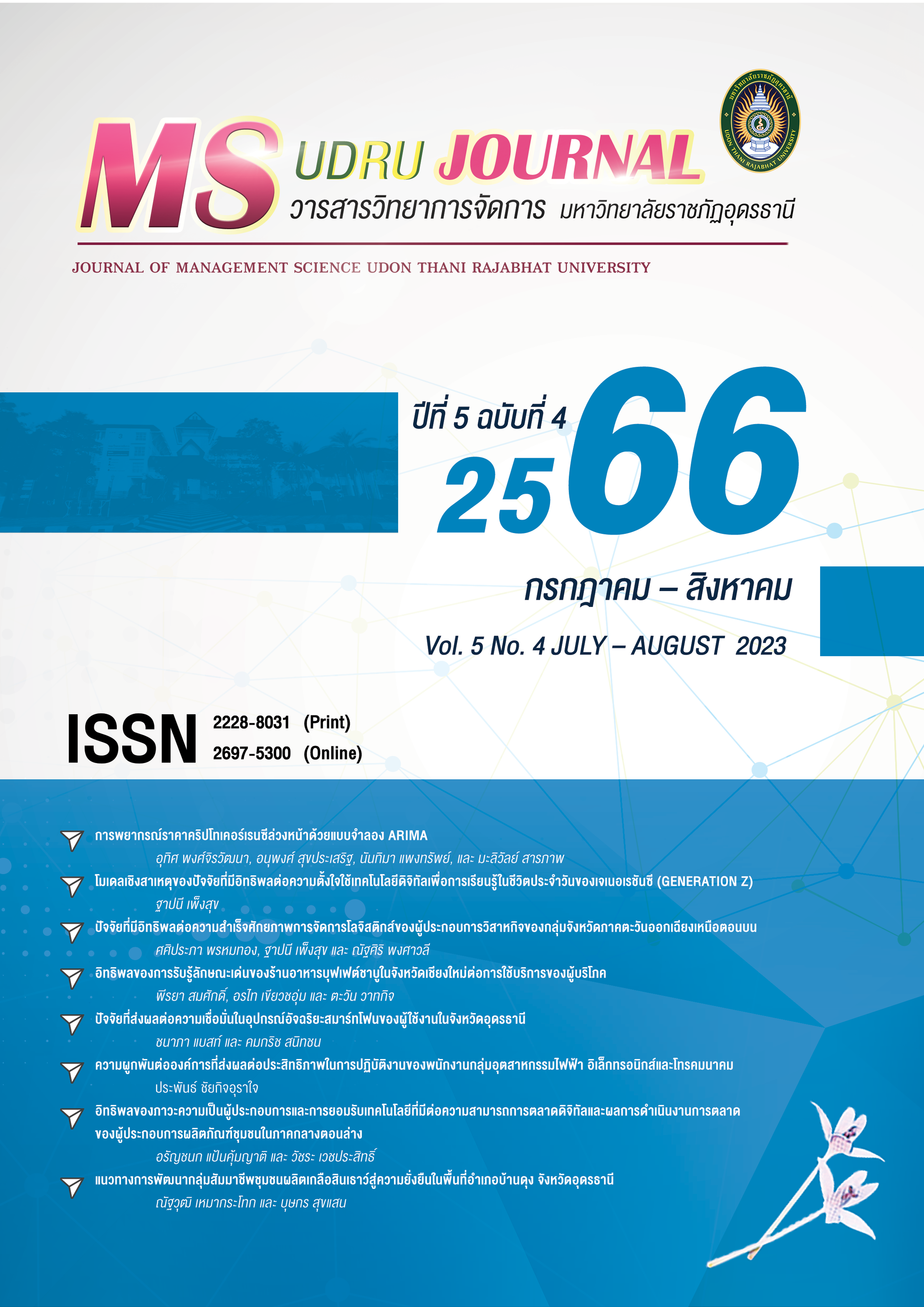โมเดลเชิงสาเหตุของปัจจัยที่มีอิทธิพลต่อความตั้งใจใช้เทคโนโลยีดิจิทัลเพื่อการเรียนรู้ในชีวิตประจำวันของเจเนอเรชันซี (GENERATION Z)
Main Article Content
บทคัดย่อ
วัตถุประสงค์ของงานวิจัยนี้คือ 1) เพื่อศึกษาอิทธิพลของการรู้สารสนเทศ ความคาดหวังจากความพยายาม และความคาดหวังในประสิทธิภาพ ที่มีต่อความตั้งใจใช้เทคโนโลยีดิจิทัลเพื่อการเรียนรู้ในชีวิตประจำวันของเจเนอเรชันซี และ 2) เพื่อตรวจสอบความสอดคล้องของความสัมพันธ์เชิงสาเหตุของปัจจัยที่มีอิทธิพลต่อความตั้งใจใช้เทคโนโลยีดิจิทัลเพื่อการเรียนรู้ในชีวิตประจำวันของเจเนอเรชันซีกับข้อมูลเชิงประจักษ์ เก็บรวบรวมข้อมูลด้วยแบบสอบถามจากกลุ่มตัวอย่างจากประชาชนที่มีอายุระหว่าง 16 – 24 ปี ในจังหวัดอุดรธานี จำนวน 586 คน ด้วยวิธีสุ่มแบบหลายขั้นตอน วิเคราะห์ข้อมูลด้วยสถิติเชิงพรรณนาและการวิเคราะห์โมเดลสมการเชิงโครงสร้าง ผลการวิจัยพบว่า โมเดลเชิงสาเหตุของปัจจัยที่มีอิทธิพลต่อความตั้งใจใช้เทคโนโลยีดิจิทัลเพื่อการเรียนรู้ในชีวิตประจำวันของเจเนอเรชันซีมีความสอดคล้องกับข้อมูลเชิงประจักษ์ พิจารณาได้จากค่า (/df = 2.41 GFI = 0.95 AGFI = 0.93 CFI = 0.99 SRMR = 0.047 RMSEA = 0.049) โดยแสดงความสัมพันธ์ ดังนี้ 1) ความคาดหวังจากความพยายาม ได้รับอิทธิพลทางตรงเชิงบวกจากการรู้สารสนเทศ 2) ความคาดหวังในประสิทธิภาพ ได้รับอิทธิพลทางตรงเชิงบวกจากการรู้สารสนเทศ และ 3) ความตั้งใจใช้งานเทคโนโลยีดิจิทัลได้รับอิทธิพลทางตรงเชิงบวกจากความคาดหวังจากความพยายามกับความคาดหวังในประสิทธิภาพ นอกจากนี้ยังได้รับอิทธิพลทางอ้อมจากการรู้สารสนเทศ ซึ่งในโมเดลทั้งหมดสามารถอธิบายค่าสัมประสิทธิ์พยากรณ์ (
) เท่ากับ ร้อยละ 70
Article Details

อนุญาตภายใต้เงื่อนไข Creative Commons Attribution-NonCommercial-NoDerivatives 4.0 International License.
บทความที่ได้รับการตีพิมพ์เป็นลิขสิทธิ์ของคณะวิทยาการจัดการ มหาวิทยาลัยราชภัฏอุดรธานี
ข้อความที่ปรากฏในบทความแต่ละเรื่องในวารสารวิชาการเล่มนี้
ไม่ใช่ความคิดเห็นและความรับผิดชอบของผู้จัดทำ บรรณาธิการ กองบรรณาธิการ และคณะวิทยาการจัดการ มหาวิทยาลัยราชภัฏอุดรธานี ความรับผิดชอบด้านเนื้อหาและการตรวจร่างบทความแต่ละเรื่องเป็นความคิดเห็นของผู้เขียนบทความแต่ละท่าน
เอกสารอ้างอิง
กระทรวงดิจิทัลเพื่อเศรษฐกิจและสังคม. (2565). ผลสำรวจพฤติกรรมการใช้อินเทอร์เน็ตของคนไทยปี 2565 Thailand Internet User Behavior 2022. สืบค้นเมื่อ 2 พฤศจิกายน 2565, จาก https://www.etda.or.th/th/Our-Service/statistics-and-information.aspx.
ธาดาธิเบศร์ ภูทอง และคณะ. (2562). ปัจจัยการยอมรับและการใช้งานแพลตฟอร์มเทคโนโลยีการทำงานร่วมกันของ กลุ่มบุคคลเจเนอเรชันซี. วารสารมนุษยศาสตร์สังคมศาสตร์และศิลปะศาสตร์ มหาวิทยาลัยศิลปากร, 12(6), 360-387.
ประสพชัย พสุนนท์. (2558). ความเที่ยงตรงของแบบสอบถามสำหรับงานวิจัยทางสังคมศาสตร์. วารสารสังคมศาสตร์ มหาวิทยาลัยศรีนครินทรวิโรฒ, 18(18), 375-396.
วัลลภา เฉลิมวงศาเวช (2560). การวิเคราะห์องค์ประกอบเชิงยืนยันของการรู้สารสนเทศของนักศึกษาในมหาวิทยาลัยเอกชน. วารสาร BU Academic Review, 16(2), 59-70.
ศุภกฤต ปิติพัฒน์. (2565). แรงจูงใจที่ส่งผลต่อความตั้งใจซื้อสินค้าเสมือนในเกมออนไลน์ของผู้บริโภคเจเนอเรชันซี. วารสารเศรษฐศาสตร์และกลยุทธ์การจัดการ, 9(1), 180-197.
Aavakare, M., & Nikou, S. (2020). University Staffs' Everyday Engagement with Digital Technology - Exploring the Role of Information Literacy and Digital Literacy, ITS Online Event, International Telecommunications Society (ITS), Calgary, 1-14.
Ahmad, F., Widén, G., & Huvila, I. (2020). The impact of workplace information literacy on organizational innovation: An empirical study. International Journal of Information Management, 51, 102041.
Ali, R., & Gupta, S. (2019). Investigating information literacy in business majors. Almaiah, M. A., Alfaisal, R., Salloum, S. A., Al-Otaibi, S., Al Sawafi, O. S., Al-Maroof, R. S., Lutfi, A., Alrawad, M., Mulhem, A. A., & Awad, A. B. (2022). Determinants influencing the continuous intention to use digital technologies in Higher Education. Electronics, 11(18), 2827.
Association of College & Research Libraries (ACRL). (2000). Information literacy competency standards for higher education. Retrieved November 11, 2022, from http://www.ala.org/acrl/standards/informationliteracycompetency.
Bent, M., & Stubbings, R. (2011). The SCONUL seven pillars of information literacy: Core model. Retrieved November 11, 2022, from https://www.sconul.ac.uk/sites/default/files/documents/coremodel.pdf.
Bentler, P. M., & Chou, C. P. (1987). Practical Issues in Structural Modeling. Sociological Methods & Research, 16(1), 78–117.
Chaouali, W., Yahia, I. B., & Souiden, N. (2016). The interplay of counter-conformity motivation, social influence, and trust in customers’ intention to adopt Internet banking services: The case of an emerging country. Journal of Retailing and Consumer Services, 28, 209–218.
Cheok, M. L., & Wong, S. L. (2015). Predictors of e-learning satisfaction in teaching and learning for school teachers: A literature review. International Journal of Instruction, 8(1), 75–90.
Cortina, J. M. (1993). What is Coefficient Alpha: An Examination of Theory and Applications? Journal of Applied Psychology, 78(1), 98-104.
Diamantopoulos, A., & Siguaw, J. A., (2000). Introduction to LISREL: A guide for the uninitiated. London: SAGE Publications.
Fornell, C., & Larcker, D. F. (1981). Evaluating Structural Equation Models with Unobservable Variables and Measurement Error. Journal of Marketing Research, 18(1), 39–50.
Foroughi, B., Nhan, P. V., Iranmanesh, M., Ghobakhloo, M., Nilashi, M., & Yadegaridehkordi, E. (2023). Determinants of intention to use autonomous vehicles: Findings from PLS-SEM and ANFIS. Journal of Retailing and Consumer Services, 70, 103158.
Hair, J. F., Black, W. C., Babin, B. J., & Anderson, R. E. (2014). Multivariate Data Analysis. (7th Ed.). Harlow, United Kingdom: Pearson Education.
Jang, M., Aavakare, M., Nikou, S., & Kim, S. (2021). The impact of literacy on intention to use digital technology for learning: A comparative study of Korea and Finland. Telecommunications Policy, 45(7), 102154.
Joosten, T., & Cusatis, R. (2020). Online learning readiness. American Journal of Distance Education, 34(3), 180–193.
Kline, R. B. (2011). Principles and Practice of Structural Equation Modeling. (3rd Ed.). New York: Guilford.
Koednet, A., Samutpaochinda, P., & Pinchinda, P. (2021). Online Classroom Management with The Smiles Model to Enhance A New Normal Learning In The Education Transformation Through Digital Technology. Panyapiwat Journal, 13(1), 294–307.
Magano, J., Silva, C., Figueiredo, C., Vitória, A., Nogueira, T., & Pimenta Dinis, M. A. (2020). Generation Z: Fitting project management soft skills competencies—A mixed-method approach. Education Sciences, 10(7), 187.
Martzoukou, K. (2021). Academic libraries in COVID-19: A renewed mission for digital literacy. Library Management, 42(4/5), 266–276.
Mohammadyari, S., & Singh, H. (2015). Understanding the effect of e-learning on individual performance: The role of digital literacy. Computers & Education, 82, 11–25.
Munoz-Leiva, F., Climent-Climent, S., & Liébana-Cabanillas, F. (2017). Determinants of intention to use the mobile banking apps: An extension of the classic TAM model. Spanish Journal of Marketing-ESIC, 21(1), 25–38.
Nikou, S., & Aavakare, M. (2021). An assessment of the interplay between literacy and digital technology in higher education. Education and Information Technologies, 26(4), 3893–3915.
Okumus, B., Ali, F., Bilgihan, A., & Ozturk, A. B. (2018). Psychological factors influencing customers’ acceptance of smartphone diet apps when ordering food at restaurants. International Journal of Hospitality Management, 72, 67–77.
Sair, S. A., & Danish, R. Q. (2018). Effect of performance expectancy and effort expectancy on the mobile commerce adoption intention through personal innovativeness among Pakistani consumers. Pakistan Journal of Commerce and social sciences (PJCSS), 12(2), 501-520.
Sewandono, R. E., Thoyib, A., Hadiwidjojo, D., & Rofiq, A. (2022). Performance expectancy of E-learning on higher institutions of education under uncertain conditions: Indonesia context. Education and Information Technologies,1–28.
Schumacker, R. E., & Lomax, R. G. (2010). A Beginner’s Guide to Structural Equation Modeling. (3rd Ed.). New Jersey: Lawrence Erlbaum.
Utomo, P., Kurniasari, F., & Purnamaningsih, P. (2021). The effects of performance expectancy, effort expectancy, facilitating condition, and habit on behavior intention in using mobile healthcare application. International Journal of Community Service & Engagement, 2(4), 183–197.
Venkatesh, V., Morris, M. G., Davis, G. B., & Davis, F. D. (2003). User acceptance of information technology: Toward a unified view. MIS Quarterly, 425–478.
Venkatesh, V., Thong, J. Y., & Xu, X. (2012). Consumer acceptance and use of information technology: Extending the unified theory of acceptance and use of technology. MIS Quarterly, 157–178.
Wong, C.-H., Tan, G. W.-H., Tan, B.-I., & Ooi, K.-B. (2015). Mobile advertising: The changing landscape of the advertising industry. Telematics and Informatics, 32(4), 720–734.


